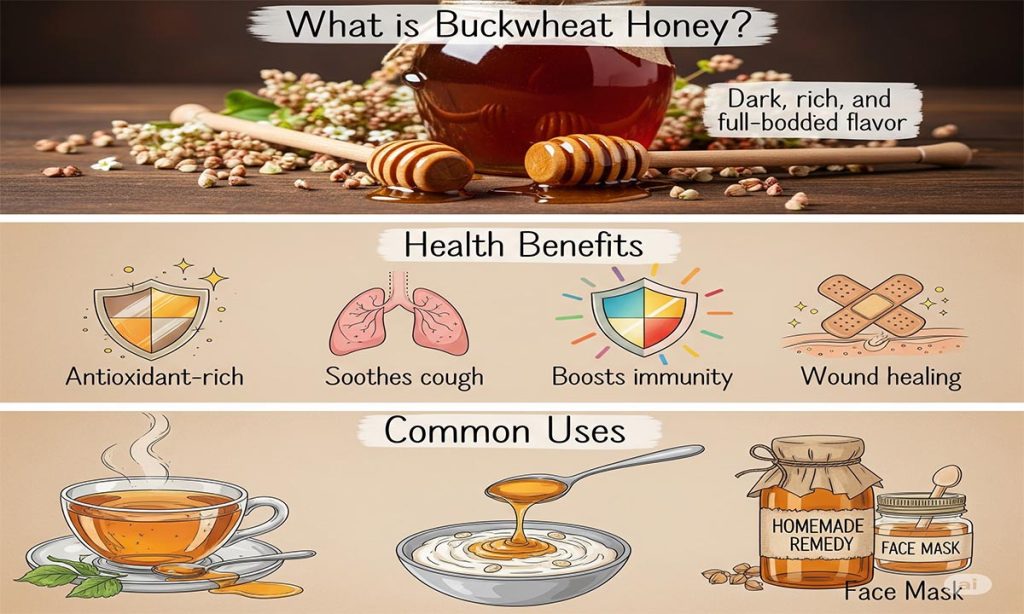Buckwheat honey is a highly nutritious, dark honey made by bees that collect nectar exclusively from buckwheat plant blossoms. Unlike common clover honeys, buckwheat honey has a deep amber to nearly black color and a robust, malty flavor. It’s not as sweet as typical honey, but it packs more antioxidants and minerals. In fact, research shows that drinking buckwheat honey can significantly boost antioxidant levels in the body. For centuries, people have prized buckwheat honey for its health benefits—from soothing coughs to supporting wound healing—while chefs use its unique flavor in marinades, baked goods, and sauces. In this article, we’ll explore what is buckwheat honey, its rich nutritional properties, key benefits, culinary and medicinal uses, how it compares to Manuka honey, and where to find the best raw buckwheat honey.

What Is Buckwheat Honey?
Buckwheat honey in a jar. Buckwheat honey is produced when bees visit the tiny white flowers of the buckwheat plant (a flowering crop, not related to wheat). It (often grown as a cover crop) blooms late in summer, yielding delicate blossoms that are irresistible to bees. Because the flowers are small, bees must work hard to gather enough nectar, which contributes to the honey’s concentrated nutrient content. The result is a very dark, rich honey – often compared to blackstrap molasses – with an earthy-malty aroma.
Buckwheat honey varies in color from dark amber to almost black. Its dark hue comes from high levels of polyphenols (antioxidant compounds) in the buckwheat nectar. In fact, each drop of it contains beneficial plant compounds like p-hydroxybenzoic acid, chlorogenic acid, and p-coumaric acid (phenolic antioxidants found in this honey). Because of these phytochemicals, buckwheat honey often has notes of molasses, caramel, and black cherry in its flavor. While lighter honeys are floral-sweet, buckwheat honey’s flavor is bold and intense, appealing to those who like a less sweet, more robust honey.
Nutritional Profile & Properties
Buckwheat honey is not only rich in flavor but also packed with nutrients. Compared to mild honeys, it generally has:
- High antioxidant content: It often ranks among the highest in antioxidant power. It contains abundant phenolic compounds and flavonoids, which scavenge free radicals. In one study, drinking it in black tea significantly boosted volunteers’ serum antioxidant capacity. Another analysis confirmed that this has very high total phenol content. In fact, buckwheat honey’s cellular antioxidant activity was found to be higher than that of premium Manuka honey. These antioxidants contribute to its dark color and may help protect the body from oxidative stress.
- Minerals and vitamins: It’s naturally rich in minerals like iron, zinc, manganese and copper. For example, it contains higher levels of iron (Fe), manganese (Mn) and zinc (Zn) compared to many other honeys. These trace minerals are vital for immune function, energy metabolism, and healing. Buckwheat honey also has B vitamins and amino acids that support health.
- Low glycemic profile: Compared to refined sugar, This has a lower glycemic index, meaning it raises blood sugar more slowly. Its relatively low GI (due to complex sugars and phenolics) can help moderate blood glucose when used in moderation. Some research suggests it may even help keep blood sugar and cholesterol levels down.
- Distinctive taste and aroma: The flavor is full-bodied and malty. Culinary experts describe it as woody, earthy, sometimes with a hint of bitter-sweetness. It’s often likened to molasses or strong black tea. This makes it ideal for cooking (it won’t disappear in flavor) and for use as a cough remedy. Because of its bold taste, a little goes a long way in recipes.
- Raw and unfiltered: It is often sold raw and unfiltered to preserve its nutrients. Unheated, unfiltered honey retains pollen and enzymes that boost its health effects. For example, one producer notes that they only gently strain it to remove impurities, keeping the pollen intact because it adds to the honey’s nutritional benefits. Look for labels saying raw buckwheat honey or raw honey to get the most healthful product.
Health Benefits of Buckwheat Honey
Buckwheat honey has been studied for numerous health-promoting effects. Key benefits include:
- Powerful antioxidant boost: As noted, buckwheat honey is extremely high in antioxidants. One human study showed that drinking buckwheat honey raised antioxidant capacity (ORAC levels) by about 7%. These antioxidants can help neutralize harmful free radicals in the body, potentially lowering inflammation and disease risk over time.
- Immune support: Its rich nutrient and antioxidant profile means buckwheat honey can support the immune system. Minerals like zinc and iron are essential for immune cell function, while flavonoids have mild anti-inflammatory effects. Some proponents even use this as a natural immune booster during cold season.
- Soothing cough and sore throat: One of the most famous uses of this is as a natural cough remedy. Clinical research found that giving children a spoonful of buckwheat honey before bed significantly reduced the frequency and severity of nighttime coughing, outperforming over-the-counter cough suppressants. It also helped the children (and parents) sleep better. Honey’s thick texture coats the throat, and its mild antimicrobial properties may calm irritation. For adults, taking a tablespoon of this in warm tea or alone can similarly soothe a sore, dry cough.
- Antibacterial and wound healing: Like other honeys, it has antibacterial properties due to its high sugar content, acidity (low pH), and natural compounds. The Dutch Gold Honey company notes that buckwheat honey was highlighted in a Penn State study as an effective cough soother, implying its therapeutic use. While Manuka honey is best known for wound healing,it also draws moisture out of wounds and inhibits many bacteria. Applying it topically (as a raw dressing) can help minor cuts, burns or skin irritations heal with less infection risk. Its nutrients and antioxidants may further promote skin repair.
- Heart health: Some research indicates this may support heart health. A study cited by Healthline showed that is helped lower cholesterol levels in the blood. Reducing LDL (“bad”) cholesterol can improve cardiovascular health and blood pressure. The combination of antioxidants, minerals, and the lower glycemic load all likely contribute to these benefits.
- Digestive aid: Buckwheat honey contains natural enzymes and prebiotic substances (like oligosaccharides) that can support gut health. It may soothe the digestive tract and promote beneficial gut bacteria. Its mild laxative effect can also help with mild constipation.
In summary, it offers healing and immune-supporting benefits. It is great for coughs and colds, as well as for general well-being due to its antioxidants and nutrients. Its natural antibacterial action means it can be used on skin wounds as a gentle topical salve. Many people report less throat irritation and faster cough relief with a spoonful of buckwheat than with medicine.
How to Use Buckwheat Honey
Buckwheat honey is versatile. Here are some top uses and tips:
- Natural sweetener: Use it in place of sugar or milder honey. Its strong, molasses-like taste makes it perfect for hearty dishes. Stir a spoon into your morning tea or coffee for a rich flavor. Drizzle it over yogurt, oatmeal or whole-grain toast for a nutritious breakfast. It also works well in smoothies and baked goods (biscuits, breads, muffins) where its robust flavor adds depth. For example, buckwheat honey can enhance marinades or barbecue sauces – Dutch Gold Honey suggests drizzling it on blue cheese, mixing it into wheat bread batter, or adding it to BBQ sauce for a tangy-sweet kick.
- Cough remedy: Take a spoonful at bedtime to coat the throat and suppress coughs. Health guidelines recommend giving children 2.5–10 mL (about ½ to 2 teaspoons, depending on age) of honey before sleep to relieve nighttime cough. This honey’s strong flavor and soothing properties make it especially effective. (Remember: no honey for infants under 1 year old, due to botulism risk.)
- Wound and skin care: Apply raw buckwheat honey directly to minor cuts, scrapes or burns and cover with a clean bandage. The honey forms a protective layer, drawing out moisture and inhibiting bacteria. It also creates a moist environment that helps skin heal with less scarring. Some people use it in homemade skincare: for instance, mix honey with a little coconut oil as a face mask or gentle cleanser. Its natural humectant quality keeps skin and hair moisturized without chemicals.
- Cooking and glazing: It has unique flavor pairs well with savory ingredients. Use it in glazes for roasted meats (like ham or pork) or roasted vegetables; it caramelizes nicely and adds complexity. It can balance spicy or tangy flavors in a sauce. It’s also good in vinaigrettes or mustard sauces. Because of its thickness, you may need to warm it slightly to pour easily.
- Beverages: Mix it into herbal teas, hot lemon water, or warm milk for a soothing drink. For a cold remedy, combine it honey with ginger and lemon in hot water as a throat-soothing tea. Its malty taste makes it an interesting alternative sweetener in lattes or smoothies.
- General topping: Simply use it as you would any honey: on pancakes, waffles, cereal or fruit. Its intense flavor means a little goes a long way, so start with ½–1 teaspoon and adjust to taste.
Each of these uses leverages buckwheat taste or health benefits. For medicinal uses (cough, wound), raw/unpasteurized is best. For cooking, either raw or pasteurized is fine, though raw retains more enzymes. When adding to recipes, note that buckwheat is less sweet, so you may need slightly more than a sweeter honey to achieve the same level of sweetness.
Buckwheat Honey vs Manuka Honey: Which Is Better?
Buckwheat honey often gets compared to Manuka honey, but they have distinct profiles:
- Source and taste: Manuka honey comes from New Zealand/Australia (bees pollinating the Manuka bush) and is prized for its medicinal qualities. It has a thick texture and a distinctive earthy, herbal-bitter taste. Honey, by contrast, comes from buckwheat flowers in North America, Europe and Asia and has a molasses-like, malty flavor. Both are dark honeys, but Manuka ranges from medium to dark amber, whereas buckwheat honey can be very dark (even black).
- Active compounds: Manuka honey is famous for its very high methylglyoxal (MGO) content, which gives it strong antibacterial activity. Buckwheat honey has much lower MGO but contains far more phenolic antioxidants. In one study, buckwheat honey had higher levels of total phenols (antioxidants) but lower MGO compared to Manuka. Both honeys have other antibacterial compounds (hydrogen peroxide, acids, etc.), but Manuka’s strength is often measured by its Unique Manuka Factor (UMF) or MGO rating.
- Antibacterial & antioxidant activity: Researchers found that buckwheat antibacterial activity against bacteria like Staphylococcus aureus and Pseudomonas aeruginosa is comparable to that of Manuka honey. Surprisingly, buckwheat honey even showed higher cellular antioxidant activity than Manuka in laboratory tests. In practical terms, this means this honey can be just as effective at killing certain germs and may better neutralize free radicals, while Manuka’s high MGO gives it extra punch against infections and in wound care.
- Health uses: Manuka honey is often used topically for wound healing and skin infections (e.g. burns, ulcers) because of its unique antibacterial properties. It is widely touted for respiratory benefits, especially cough relief. Both can support immunity and healing. Some experts say: “If you’re a Manuka fan, consider trying buckwheat honey – it can be just as effective for many uses, at a lower cost”.
- Cost and availability: Manuka honey (especially high-UMF) is usually much more expensive and imported. This is more affordable and often locally available in temperate regions. Brands like Dutch Gold and Radiance sell North American buckwheat honey, while Gunter’s Pure Honey offers a retail buckwheat honey in the U.S. because it grows in places like New York, Pennsylvania, Montana and the Dakotas.
In summary, buckwheat vs Manuka is not about “better or worse” but different strengths. If your goal is antioxidants, cough relief, or you want a dark flavorful honey, buckwheat is excellent. If you need intense wound care or high antibacterial potency, Manuka is favored. For everyday use, buckwheat honey gives great medicinal benefits at a bargain price.
Where to Buy Buckwheat Honey (Near Me)
Looking for where to buy this honey? Because buckwheat blooms vary by region, availability can be seasonal, but these tips help:
- Local honey farms and markets: Many small beekeepers produce buckwheat honey when they plant buckwheat as a cover crop. Check farmers’ markets, health food co-ops, or local honey shops in late summer/early fall (when buckwheat blooms). Ask apiaries if they sell a buckwheat variety. Searching online for “buckwheat honey near me” may turn up nearby farms or health stores that stock it. Buying local ensures freshness and supports honest labeling.
- Natural food stores: National chains like Whole Foods or Trader Joe’s sometimes carry it in their bulk sections or honey aisles. Specialty grocers (e.g. Naturalia, Earth Fare) often have unfiltered buckwheat honey jars from regional producers. Health stores and vitamin shops may also stock raw buckwheat honey.
- Online retailers: Many brands sell raw it online. For example, Dutch Gold Honey offers a 1-pound jar of American buckwheat honey (origin New York/Montana). Other brands like Radiance, Kiwi, or local apiaries ship buckwheat honey nationwide. Large online marketplaces (Amazon, Thrive Market) carry it as well – search “buckwheat honey raw” or “buckwheat honey 5 lb pail.” When ordering, read product reviews to ensure authenticity.
- Major retailers: Some grocery chains carry buckwheat as a specialty item. Gunter’s Pure Honey (sold in Hy-Vee and Walmart stores) offers a 16-oz Buckwheat variety. Dutch Gold products are in many US supermarkets. Even if “buckwheat honey near me” doesn’t show a local store, you can often special-order it through a friendly grocer or find it on Amazon.
- Organic and raw: If you want raw buckwheat honey, look for labels that say “Raw & Unfiltered”. Certified organic buckwheat honey exists from small farms, but even non-organic is usually pure honey (honey can’t be radiated, only possible GMO risk is trace; certified organic ensures no pesticides in bees’ habitat).
No matter where you buy, check that the ingredient is 100% honey (no added syrup) and preferably 100% buckwheat or unblended honey. True buckwheat honey will be very dark in color.
Using Buckwheat Honey in Daily Life
To maximize its benefits and flavor, integrate buckwheat honey into your routine:
- Morning energizer: Stir a teaspoon into hot lemon water or herbal tea instead of sugar. Its antioxidants kick-start your day.
- Tea-time remedy: Brew ginger or chamomile tea and sweeten with buckwheat honey for cold relief.
- Snack enhancement: Spread on whole-grain crackers with peanut butter for a nutrient-rich snack.
- Cooking and baking: Replace regular honey or molasses in recipes. For example, use buckwheat honey in pumpkin pie, gingerbread, or barbecue glaze. Its rich taste pairs well with spices and meats.
- Topical care: Keep a jar in your first-aid kit. Use it as a natural bandage for minor burns or cuts, or apply to bug bites to reduce itch and infection risk.
- Face mask: Mix buckwheat honey with a bit of yogurt or oatmeal for a homemade moisturizing mask. Leave on 15 minutes, rinse for smooth skin.
- Nightcap: For cold symptoms, have a spoonful before bed. The sweet aroma can be relaxing and the honey will soothe your throat overnight.
Because buckwheat honey is so strong, start with small amounts if you’re new to it. Its taste can be intense at first, but many people learn to love its unique profile.
Frequently Asked Questions (FAQ)
Q: What is buckwheat honey and how is it different from regular honey?
A: Buckwheat honey is a mono-floral honey made from the nectar of buckwheat flowers. Unlike milder honeys, it is very dark in color (deep amber to black) and has a strong, malty flavor. It’s less sweet and much richer in antioxidants and minerals than typical honey. Buckwheat itself is not a grain but a leafy plant (related to rhubarb), so the honey’s profile is quite different from wheat-based or generic clover honey.
Q: What does buckwheat honey taste like?
A: Buckwheat honey has a robust, earthy taste. Connoisseurs describe it as malty, with molasses and dark fruit (cherry or berry) notes. It can be slightly bitter or smoky to some palates. Because of this, it pairs well with strong flavors (like cheese or meat) and can add depth to sweet dishes. Its bold taste is one reason many people use it sparingly.
Q: What are the health benefits of buckwheat honey?
A: Buckwheat honey is packed with health-promoting compounds. It boosts antioxidants and immune support due to its high phenolic content. It’s antibacterial and can aid wound healing, similar to Manuka honey. It also soothes coughs and sore throats – studies show it outperforms OTC cough medicine in kids. Other reported benefits include lowering cholesterol and supporting heart health. Overall, its unique nutrients may promote healing and prevent inflammation.
Q: How do I use buckwheat honey for a cough?
A: For cough relief, take it straight or stirred in warm tea. Pediatricians recommend one dose of honey before bedtime: about 2.5 mL (½ tsp) for ages 2–5, 5 mL for ages 6–11, and 10 mL (2 tsp) for ages 12–18. A spoonful of buckwheat honey can coat the throat, reduce coughing, and improve sleep. It’s important not to give honey to infants under 1 year old. For adults, a tablespoon of buckwheat honey in herbal tea can also help ease throat irritation and cough.
Q: Where can I buy the best buckwheat honey (including raw or near me)?
A: You can find buckwheat honey at farmers markets, health food stores, and online. Local beekeepers often sell raw buckwheat honey directly in late summer. Searching “buckwheat honey near me” online may show nearby sources. Major brands like Dutch Gold (USA) sell buckwheat honey jars, and Gunter’s or local honey producers sell it in grocery stores. For raw, look for “raw & unfiltered buckwheat honey.” Buying from local farms or co-ops can ensure freshness and purity.
Conclusion
Buckwheat honey is a nutrient-rich “super-honey” prized for its dark color, bold flavor, and health benefits. Whether you’re looking to soothe a cough, add antioxidants to your diet, or simply enjoy a unique natural sweetener, buckwheat honey delivers. It contains more antioxidants and minerals than common honeys and has been shown to relieve coughs better than some medicines. Compared to Manuka honey, buckwheat is often more affordable while still offering strong antibacterial and antioxidant effects.
If you’re interested, try incorporating buckwheat honey into your cooking or home remedies. Share your favorite ways to use it (perhaps on social media or in the comments) to help others discover this “liquid gold.” We hope this guide helped you understand buckwheat honey – its taste, benefits, and uses – and can help you find and use this wholesome sweetener in your life.
Sources: The information above is supported by scientific research and expert sources, including a Penn State study on cough relief, a Journal of Agricultural and Food Chemistry study on antioxidants, comparative analyses of buckwheat vs Manuka honey, and health articles on buckwheat honey benefits.






2 thoughts on “Buckwheat Honey: Benefits, Uses, and More”